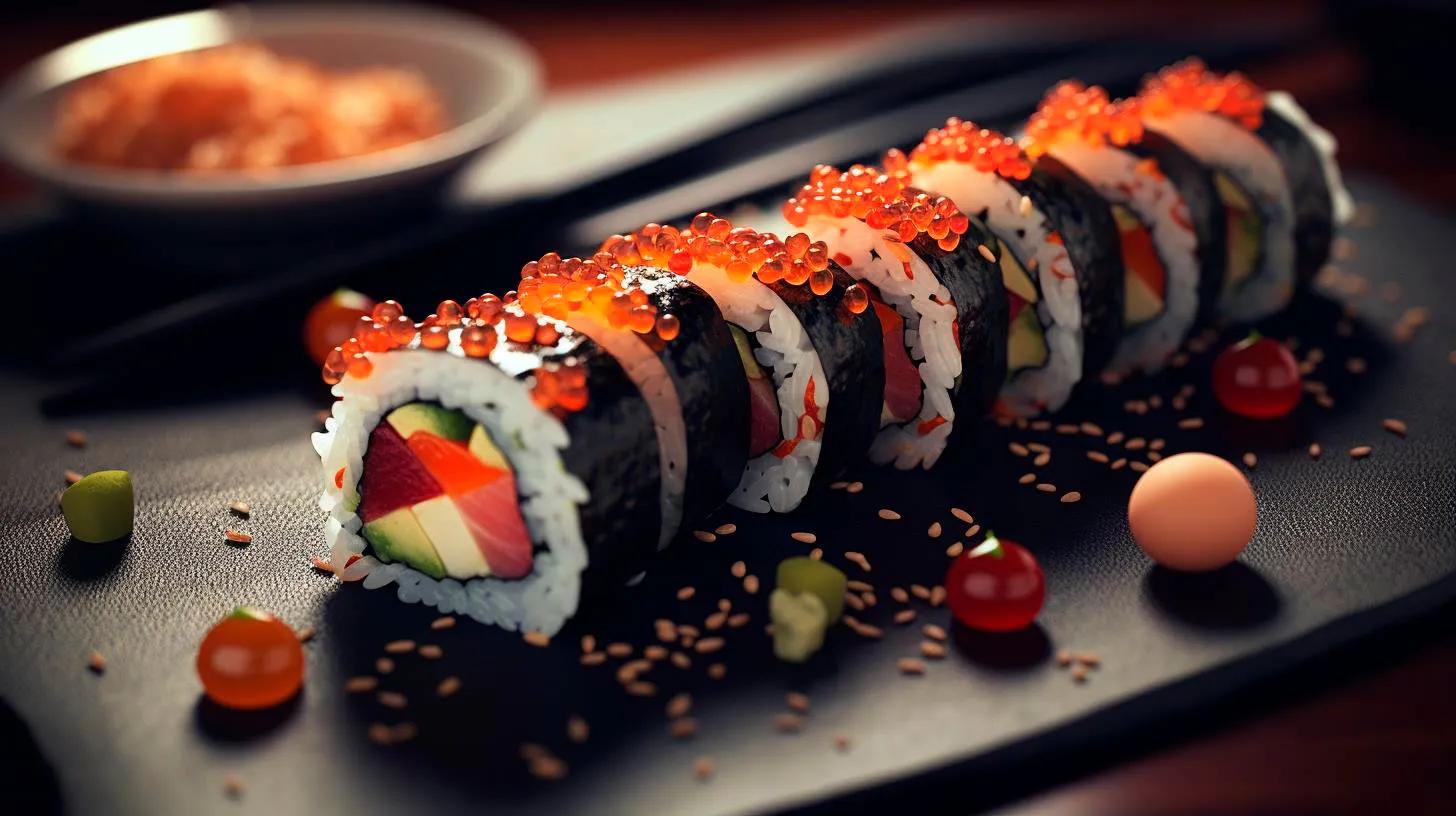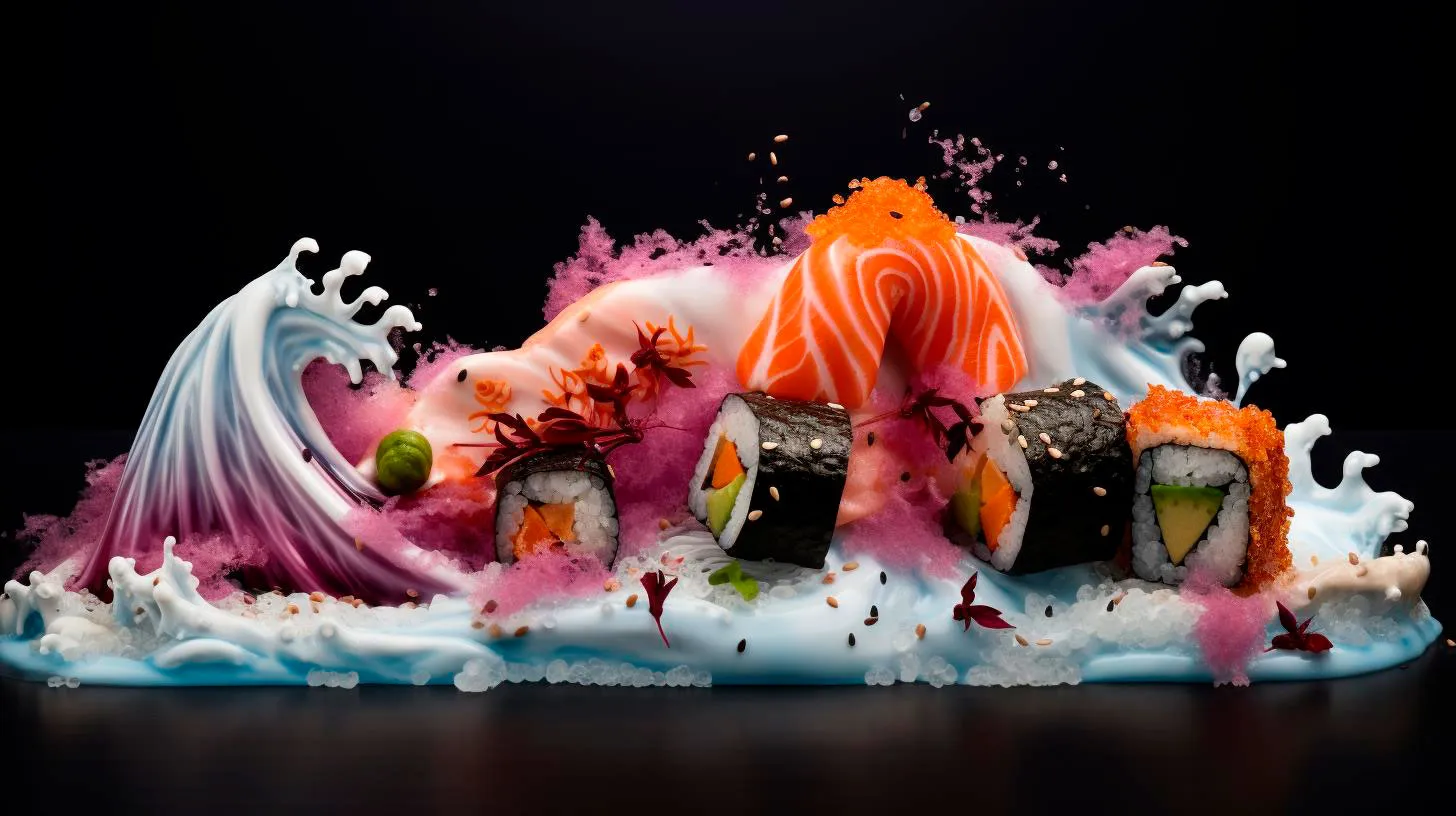Symbolism and Tradition: Unveiling the Secrets of Sushi Making
The Artistry of Sushi
Creating sushi is a meticulous process that requires years of practice and a keen eye for detail. It combines technical precision with artistic flair, resulting in visually captivating dishes that are as pleasing to the eye as they are to the palate. From the selection of ingredients to the presentation on the plate, every step is deliberate and purposeful.
The Ingredients: A Symphony of Flavors
At the heart of sushi making lies the selection of ingredients, with each element contributing to the overall harmony of flavors. Some key components include:
- Sashimi-Grade Fish: Freshness is paramount when it comes to selecting the fish for sushi. The delicate slices of sashimi-grade fish, such as tuna, salmon, and yellowtail, symbolize the ocean’s bounty and are known for their umami-rich flavors.
- Shari (Sushi Rice): The foundation of sushi, shari refers to the seasoned sushi rice. The balance between vinegar, sugar, and salt in the seasoning enhances the flavors of the other ingredients while providing a soft texture that complements the fish.
- Nori (Seaweed): Made from edible seaweed, nori serves as the wrapping for sushi rolls. Its umami-rich taste and crispy texture add depth to the overall experience.
- Wasabi and Pickled Ginger: These condiments enhance the flavors of sushi and serve as palate cleansers between bites. Wasabi, a spicy green paste, enlivens the taste buds, while pickled ginger refreshes the palate.
The Techniques: Precision and Grace
Sushi chefs, known as itamae, have honed their skills over years of practice to master techniques that highlight the delicate flavors and textures of each ingredient. These techniques include:
- Knife Skills: The precise art of slicing fish, known as sashimi, requires mastery of the knife. The cuts must be clean, ensuring even thickness and maintaining the integrity of the fish.
- Maki Roll Preparation: Creating the iconic sushi rolls involves expertly rolling the ingredients in nori and cutting them into uniform slices. The ability to achieve a tight roll while maintaining the aesthetics is essential.
- Seasoning Mastery: Achieving the perfect balance of flavors in sushi rice is a skill in itself. Sushi chefs carefully season the rice, using just the right amount of vinegar, sugar, and salt to complement the fish and other ingredients.
The Symbolism Behind Sushi
While sushi is renowned for its flavors and artistry, it also carries rich symbolism that adds depth to the dining experience. Understanding the cultural significance of sushi enhances our appreciation for this cherished tradition:
- Purity and Simplicity: Sushi embodies the Japanese aesthetic of simplicity and minimalism, both in its presentation and ingredients. Its clean flavors and unadorned appearance reflect the beauty found in simplicity.
- Respect for Nature: The use of fresh, seasonal ingredients in sushi reflects Japan’s reverence for nature. Sourcing local and sustainable seafood not only showcases respect for the environment but also highlights the natural flavors of each ingredient.
- Harmony and Balance: The visual harmony of colors, shapes, and textures in a sushi platter represents the belief in achieving balance in all aspects of life. The balance between fish, rice, and other ingredients creates a harmonious bite that delights the senses.
The Joy of Sushi
Aside from its cultural significance and intricate preparation, sushi offers a myriad of benefits that extend beyond the dining experience. Here are some key takeaways:
- Health Benefits: Sushi is a nutritious choice, rich in omega-3 fatty acids, lean protein, and beneficial minerals. It is a heart-healthy option that can contribute to overall well-being.
- Culinary Exploration: Sushi provides an opportunity to explore new flavors and ingredients. From traditional nigiri to modern fusion rolls, the world of sushi offers endless possibilities for culinary adventure.
- Cultural Appreciation: By understanding the symbolism and traditions of sushi, we gain a deeper appreciation for Japanese culture and its culinary heritage. It allows us to connect with different customs and traditions from around the world.
As we savor the artistry and symbolism of sushi, let us embark on a sensory journey that transcends boundaries. Whether you are a seasoned sushi connoisseur or a curious novice, the secrets behind its creation add an extra layer of intrigue and magic to this beloved dish.
From Raw Fish to Creative Rolls: The Evolution of Sushi Culture
From its humble origins as a simple street food to the sophisticated and creative rolls we know today, sushi has undergone a remarkable evolution, reflecting the ever-changing tastes and preferences of its diverse global audience.
The Birth of Sushi: A Culinary Journey
Sushi, originally referred to as “Nare-zushi,” was born in Southeast Asia over 2000 years ago. This ancient technique was devised as a preservation method, allowing fish to ferment with rice and salt, leading to a tangy and pungent flavor. During the 8th century, Japan adopted this preservation method, transforming it into “Nigiri-zushi,” where the fish was no longer fermented but instead served atop vinegared rice.
- Key Takeaway: The birth of sushi can be traced back to ancient Southeast Asia, evolving into the nigiri-zushi we know today.
Sushi Goes Global: The Impact of Cultural Exchange
In the mid-19th century, sushi made its way beyond Japan’s borders and gained popularity in other parts of the world. As Japanese immigrants migrated to countries like the United States, they brought their culinary traditions with them. Initially, sushi was only available in exclusive Japanese restaurants, but it gradually found its way into mainstream Western dining culture. This cultural exchange contributed to the diverse range of sushi styles we now have, including California rolls and tempura rolls.
- Key Takeaway: Cultural exchange and migration played a significant role in introducing sushi to the global palate, resulting in the development of various sushi styles.
Sushi Enters the Modern Age: Creativity Unleashed
In recent years, sushi has undergone a revolution, with chefs pushing boundaries and embracing their creativity. The introduction of innovative ingredients, diverse flavor combinations, and artistic presentation have transformed sushi into a culinary art form. Chefs have moved beyond traditional sushi rolls and introduced fusion variations such as sushi burritos, sushi burgers, and even dessert sushi, catering to a wider range of preferences and dietary restrictions.
- Key Takeaway: The modern sushi scene thrives on creativity, with chefs constantly experimenting and introducing unique flavor combinations and innovative presentations.
The Health Benefits of Sushi: A Nutritious Delight
Sushi not only tantalizes the taste buds but also offers numerous health benefits. These bite-sized delicacies are packed with essential nutrients, including omega-3 fatty acids, vitamins, and minerals. Additionally, sushi often incorporates nutrient-rich ingredients such as seaweed, seafood, and vegetables. It’s a heart-healthy option that can support brain function, reduce the risk of chronic diseases, and even enhance weight management.
- Key Takeaway: Sushi provides a healthy and nutritious dining option, packed with essential nutrients and beneficial ingredients.
The Future of Sushi: Tech Innovations and Sustainability
As we look to the future, sushi continues to evolve, incorporating technological advancements and sustainable practices. From sushi-making robots streamlining the preparation process to farm-raised fish reducing strain on wild populations, the sushi industry embraces innovation with a focus on efficiency and environmental responsibility. Advancements like these ensure that sushi remains accessible and sustainable for generations to come.
- Key Takeaway: The future of sushi is shaped by technological innovations and sustainable practices, ensuring its continued growth and accessibility.
From its humble beginnings as fermented fish and rice to the intricate rolls we savor today, sushi’s evolution has been nothing short of remarkable. Cultural exchanges, creativity, health benefits, and sustainability have all played a crucial role in shaping sushi into the beloved cuisine it is today. So, the next time you indulge in a sushi feast, savor not only the flavors but also the rich history and the dedication of countless sushi artisans who continue to push the boundaries of this culinary art form.
Sushi: The Art of Delightful Japanese Cuisine
The Origins of Sushi
The history of sushi dates back to ancient times in Southeast Asia. The traditional method of preserving fish by fermenting it in rice allowed people to store fish for several months. This technique eventually made its way to Japan around the 8th century AD.
In Japan, sushi evolved from being a form of preservation to becoming a culinary delicacy. During the Edo period (1603-1868), sushi became widely popular in the form we know today. The introduction of vinegar-infused rice, known as “sushi rice,” transformed sushi into a more palatable dish.
Types of Sushi
When it comes to sushi, there is a wide variety of options to choose from. Here are some of the most popular types:
- Nigiri: A classic sushi style consisting of a small mound of sushi rice topped with a slice of raw or cooked fish or seafood.
- Maki: Rolled sushi wrapped in seaweed, with various fillings such as fish, vegetables, or even cooked meat. Maki is often cut into bite-sized pieces.
- Sashimi: Thinly sliced raw fish or seafood served without rice.
- Temaki: Hand-rolled sushi resembling a cone shape, filled with rice, fish, and vegetables.
These are just a few examples of the wide range of sushi options available. Each type offers a unique taste and texture experience, ensuring there is something for everyone.
The Cultural Significance of Sushi
In Japan, sushi is not merely a meal; it is deeply rooted in the country’s culture and traditions. Here are some key aspects of sushi’s cultural significance:
- Symbol of Japanese Cuisine: Sushi is a quintessential representation of Japanese food culture worldwide, showcasing the country’s emphasis on fresh, high-quality ingredients and meticulous preparation.
- Precision and Mastery: Preparing sushi requires years of practice and skill. Sushi chefs, known as itamae, undergo rigorous training to deliver the highest quality sushi.
- Dining Etiquette: Sushi dining etiquette is highly regarded in Japan. It is customary to use chopsticks when enjoying sushi and to eat it in one bite, showing respect for the chef’s craftsmanship.
- Seasonal Ingredients: Sushi is heavily influenced by the changing seasons in Japan. Chefs incorporate seasonal ingredients to ensure the freshest and most flavorful sushi possible.
Health Benefits of Sushi
Sushi not only provides a delightful culinary experience but also offers various health benefits:
- Omega-3 Fatty Acids: Sushi, especially those containing fatty fish like salmon or tuna, is a great source of omega-3 fatty acids, which have numerous heart health benefits.
- Protein-Rich: Sushi is packed with protein, making it a satisfying and nutritious meal option.
- Low in Calories: Sushi rolls with vegetables or fish tend to be low in calories, making them an ideal choice for those watching their calorie intake.
- Rich in Minerals and Vitamins: Sushi ingredients like seaweed, ginger, and wasabi are rich in minerals and vitamins, providing additional nutritional value.
Key Takeaways
Sushi is a culinary art form that has captured the hearts and palates of people worldwide. Here are some key takeaways to remember:
- Sushi originated in Japan and has a rich cultural history.
- There are various types of sushi, including nigiri, maki, sashimi, and temaki.
- Sushi represents precision, mastery, and seasonal ingredients.
- It offers numerous health benefits, such as omega-3 fatty acids and protein.
Indulging in the art of sushi allows us to savor not only its exquisite taste but also the centuries-old traditions and meticulous craft behind it. So, the next time you have the opportunity to enjoy sushi, relish every bite and appreciate the artistry that goes into creating this delightful Japanese cuisine.
Exploring Sushi: From Tradition to Modern Fusion Creations
The Traditional Roots of Sushi
Sushi traces its roots back to 2nd century AD, where it was initially developed as a method of preserving fish in fermented rice. Over time, the fermentation process was abandoned, and rice started to be consumed along with the fish. This early form of sushi, known as Narezushi, laid the foundation for the plethora of sushi variations we enjoy today.
As time passed, sushi culture flourished in Japan, and various traditional styles emerged. Some notable traditional sushi types include:
- Nigiri: A classic form of sushi, consisting of a small hand-pressed mound of rice topped with a slice of fresh fish or seafood.
- Maki: Sushi rolls made by wrapping a sheet of nori (dried seaweed) around vinegared rice, with different fillings such as fish, vegetables, or tempura.
- Sashimi: Thinly sliced, raw fish or seafood served without rice. It showcases the natural flavors and textures of the ingredients.
- Tempura: A delightful addition to sushi, tempura is a Japanese frying technique used to create crispy, battered seafood or vegetables.
These traditional sushi styles continue to be widely adored by sushi enthusiasts worldwide for their simplicity, elegance, and authentic flavors.
Enter the Modern Fusion Creations
As sushi gained popularity globally, innovative chefs began experimenting with new ingredients, flavors, and techniques, giving rise to modern fusion sushi. This contemporary twist on tradition offers a whole new world of thrilling sushi experiences. Let’s explore some key features and advantages of modern fusion sushi:
Fusion Flavors
Modern fusion sushi blends traditional Japanese ingredients and techniques with flavors from different cuisines worldwide. By incorporating elements from Thai, Mexican, or even Italian cuisine, fusion sushi creates unique flavor profiles that tantalize taste buds.
Unconventional Ingredients
Fusion sushi pushes the boundaries of traditional sushi by introducing unexpected ingredients. It’s not uncommon to find ingredients like mango, avocado, cream cheese, or even truffle in these creations. These additions enhance flavor, texture, and visual appeal, elevating the sushi experience to new heights.
Artistic Presentation
Modern fusion sushi is a feast for the eyes. Chefs take inspiration from Japanese art and transform sushi into edible masterpieces. Intricate rolls, vibrant colors, and meticulous plating techniques make fusion sushi a visual delight, ready to be shared on social media platforms.
Accessibility and Adaptability
Modern fusion sushi caters to diverse palates and dietary preferences. From vegetarian and vegan options to gluten-free variations, there is something for everyone. This inclusivity has played a significant role in the increasing popularity of sushi worldwide.
Key Takeaways
As we wrap up our journey through the evolution of sushi, here are some key takeaways to remember:
- Sushi originated from Japan and has a rich history dating back centuries.
- Traditional sushi types include nigiri, maki, sashimi, and tempura.
- Modern fusion sushi blends flavors from different cuisines, introduces unconventional ingredients, and showcases artistic presentation.
- Fusion sushi caters to diverse dietary preferences and has contributed to its growing popularity globally.
So, whether you prefer the elegance and tradition of classic sushi or crave the innovative flavors of fusion creations, sushi continues to captivate food enthusiasts around the world. Embark on your own sushi adventure and experience the harmony of flavors, textures, and cultural influences that make sushi truly extraordinary.


